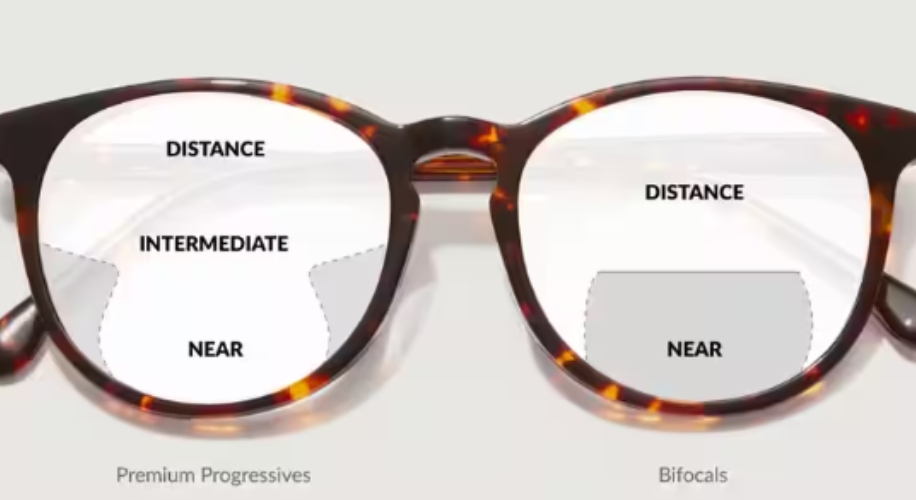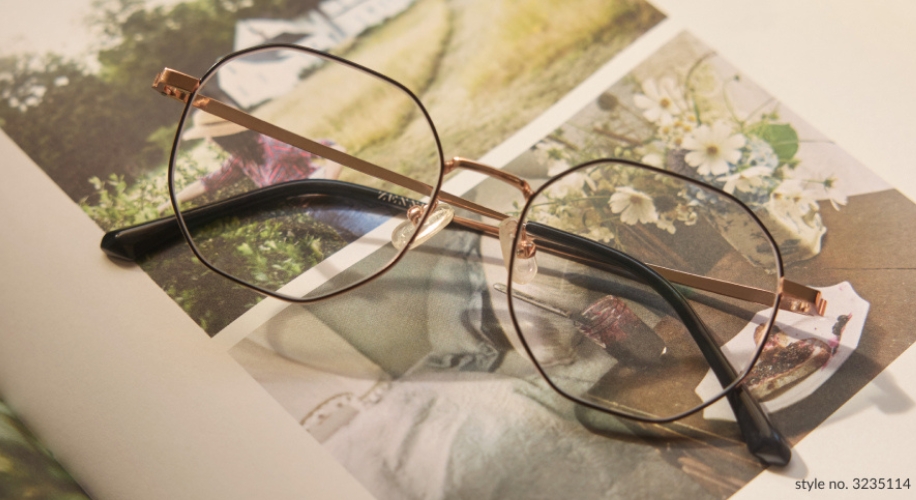A Comprehensive Guide to Progressive Lenses: Are They Right for You?
@zenni Are you at that point in life where you have a pair of glasses for reading, another for driving, and yet another for computer work? Progressive lenses are your all in one solution 🙌🤓 #optometry #optometrist #eyedr #eyedoctor #zenni #eyeglasses #progressivelenses #nearsighted #farsighted #badeyesight ♬ original sound – Zenni Optical
Progressive lenses have revolutionized the way millions of people experience vision correction, offering a seamless solution for presbyopia and other vision issues. In this guide, we’ll delve into the world of progressive glasses, exploring what they are, how they work, and whether they’re the right choice for you.
What Are Progressive Lenses?
Progressive lenses, often referred to as “no-line bifocals,” are multifocal lenses that offer three vision powers in one seamless lens. These powers include:
- Distance vision – at the top portion of the lens, ideal for daily activities like driving or watching TV.
- Intermediate vision – in the middle portion, perfect for computer work or viewing the dashboard in your car.
- Near vision – at the bottom, for reading or any other close-up task.
The magic of progressive lenses lies in the gradual change in prescription power as you move your eyes from the top to the bottom of the lens. This design mimics the natural vision process and removes the abrupt shift in focus associated with traditional line bifocals.
When it comes to vision correction, progressive lenses stand out as a remarkable innovation, particularly for individuals experiencing presbyopia, which is a common age-related issue that affects the ability to see clearly at different distances. Unlike traditional bifocals or trifocals, progressive lenses offer a smooth transition between multiple prescription strengths, providing clear vision at all ranges without the telltale lines on the lenses. Let’s delve into the world of progressive lenses and explore how they can enhance your daily visual experience.
Advantages of Progressive Lenses
Opting for progressive lenses presents several benefits that enhance both your vision and lifestyle:
- Natural Vision Correction: Progressive lenses provide a more natural correction of presbyopia. Unlike bifocals or trifocals, they do not force your eyes to jump from one prescription strength to another, which can be jarring and uncomfortable.
- Visual Appeal: With no visible lines, progressive lenses have a modern, sleek appearance that is indistinguishable from regular single-vision lenses, which can be a big boost to your confidence.
- Convenience: These lenses eliminate the need for multiple pairs of glasses. Whether you’re looking at objects far away, working on your computer, or reading a book, you don’t need to switch between different pairs of glasses.
- Customizable Options: Progressive lenses can be tailored to fit a variety of eyeglass frames, including stylish frames for different face shapes and preferences.
The seamless functionality of progressive lenses means you can enjoy uninterrupted vision, from the moment you put them on until the end of the day. Plus, they can be made with protective coatings, such as UV filters and blue light blocking, to safeguard your eyes from harmful light sources.
Pros and Cons of Progressive Lenses: Is It Worth It?
While progressive lenses offer numerous benefits, including seamless vision correction and convenience, they may not be suitable for everyone. One of the main drawbacks of progressive lenses is the adjustment period required to get used to the seamless transition between different focal points. Some individuals may experience issues such as distortion or peripheral blurring during the initial adaptation period. However, with time and patience, most people find that the benefits of progressive lenses far outweigh any initial challenges.
Tips for Wearing Progressive Lenses: Making the Transition Smooth
If you’re considering progressive lenses, there are a few tips to keep in mind to ensure a smooth transition:
- Allow for an Adjustment Period: It’s normal to experience some discomfort or visual disturbances during the initial adjustment period. Give yourself time to adapt to the new lenses, and don’t hesitate to contact your eye care professional if you have any concerns.
- Keep Your Prescription Up to Date: Regular eye exams are essential for maintaining optimal vision and ensuring that your prescription is accurate. Be sure to schedule routine appointments with your eye care provider to monitor any changes in your vision.
- Choose the Right Frames: The size and shape of your frames can have a significant impact on your comfort and visual clarity with progressive lenses. Be sure to select frames that are compatible with your prescription and provide adequate coverage for the different focal points.
- Practice Good Posture: Proper posture can help maximize the performance of your progressive lenses. When reading or performing close-up tasks, make sure to maintain a comfortable distance between your eyes and the reading material, and avoid tilting your head too far up or down.
Understanding Presbyopia: The Need for Progressive Lenses
Presbyopia is a common age-related condition that affects near vision, making it difficult to focus on close-up objects. As we age, the lens of the eye becomes less flexible, resulting in challenges with tasks like reading, using smartphones, or working on computers. Progressive lenses are designed to address this issue by providing a gradual transition from distance to near vision, allowing for clear vision at all distances without the need for multiple pairs of glasses.
How Progressive Lenses Work: A Seamless Solution
Unlike traditional bifocals or trifocals, which have distinct lines separating different lens powers, progressive lenses offer a smooth, continuous transition between near, intermediate, and distance vision. This is achieved through a gradual change in lens power from the top to the bottom of the lens, providing clear vision at all distances without any noticeable lines or disruptions.
Progressive Lenses: Finding the Right Fit
When comparing progressive and single vision lenses, it’s essential to consider your specific vision needs and lifestyle. Single vision lenses are ideal for individuals who require correction for only one type of vision, such as near or distance vision. They provide clear and focused vision at a single distance, making them suitable for tasks like reading or driving. Progressive lenses, on the other hand, offer a seamless transition between different focal points, allowing for clear vision at all distances without the need for multiple pairs of glasses. While single vision lenses may be more straightforward to adjust to initially, progressive lenses provide greater versatility and convenience for individuals with presbyopia or other vision issues.

Progressive vs. Bifocal Lenses: Deciphering the Differences
When deciding between progressive and bifocal lenses, it’s essential to understand the key differences and advantages of each option. Bifocal lenses feature distinct lines separating different lens powers, typically offering two focal points for near and distance vision. While bifocals provide clear vision at multiple distances, the visible lines can be distracting and aesthetically displeasing for some wearers. In contrast, progressive lenses offer a smooth and seamless transition between different focal points, eliminating the need for visible lines and providing a more natural viewing experience. Additionally, progressive lenses offer a wider range of vision correction compared to bifocals, making them a preferred choice for individuals with presbyopia or those seeking enhanced visual comfort and aesthetics.
Tips for Choosing Frames for Progressive Lenses
Be sure to explore these essential tips for selecting frames tailored to your progressive lenses, ensuring both optimal vision and style alignment.
- Consider Frame Size and Shape: Progressive lenses have distinct zones for near, intermediate, and distance vision. Therefore, the frame should be large enough to accommodate these segments without compromising on style. Frames with a deeper lens area, such as square or round shapes, are ideal for progressive lenses.
- Look for Adjustable Nose Pads: Frames with adjustable nose pads allow for a customized fit, ensuring the progressive lenses align properly with your eyes.
- Opt for Lightweight Materials: Lightweight materials such as acetate or titanium reduce the overall weight of the glasses, increasing comfort during extended wear.
- Avoid Small or Narrow Frames: Small or narrow frames may limit the size of the progressive lens, compromising vision quality and comfort.
- Consider Frame Style and Fashion Preferences: Choose frames that complement your personal style and fashion preferences, ensuring you feel confident and stylish while wearing your progressive lenses.
In conclusion, progressive glasses offer a convenient and effective solution for presbyopia and other vision issues, providing clear vision at all distances without the need for multiple pairs of glasses. While they may require some adjustment initially, most people find that the benefits of progressive lenses far outweigh any challenges. If you’re considering progressive lenses, be sure to consult with your eye care professional to determine if they’re the right choice for you.







 Canada
Canada